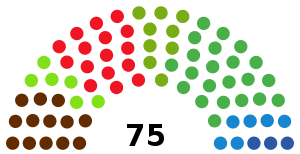Basque regional election, 1990
|
| |||||||||||||||||||||||||||||||||||||||||||||||||||||||||||||||||||||||||||||||||||||||||||||
| |||||||||||||||||||||||||||||||||||||||||||||||||||||||||||||||||||||||||||||||||||||||||||||
All 75 seats in the Basque Parliament 38 seats needed for a majority | |||||||||||||||||||||||||||||||||||||||||||||||||||||||||||||||||||||||||||||||||||||||||||||
|---|---|---|---|---|---|---|---|---|---|---|---|---|---|---|---|---|---|---|---|---|---|---|---|---|---|---|---|---|---|---|---|---|---|---|---|---|---|---|---|---|---|---|---|---|---|---|---|---|---|---|---|---|---|---|---|---|---|---|---|---|---|---|---|---|---|---|---|---|---|---|---|---|---|---|---|---|---|---|---|---|---|---|---|---|---|---|---|---|---|---|---|---|---|
| Registered |
1,687,936 | ||||||||||||||||||||||||||||||||||||||||||||||||||||||||||||||||||||||||||||||||||||||||||||
| Turnout |
1,029,457 (61.0%) | ||||||||||||||||||||||||||||||||||||||||||||||||||||||||||||||||||||||||||||||||||||||||||||
| |||||||||||||||||||||||||||||||||||||||||||||||||||||||||||||||||||||||||||||||||||||||||||||
 Constituency results map for the Basque Parliament | |||||||||||||||||||||||||||||||||||||||||||||||||||||||||||||||||||||||||||||||||||||||||||||
| |||||||||||||||||||||||||||||||||||||||||||||||||||||||||||||||||||||||||||||||||||||||||||||
The 1990 Basque regional election was held on Sunday, 28 October 1990, to elect the 4th Parliament of the Basque Autonomous Community. All 75 seats in the Parliament were up for election.
The Basque Nationalist Party (EAJ/PNV) won 22 seats, the Socialist Party of the Basque Country (PSE–PSOE) came second with 16 seats, People's Unity (HB) came third with 13 seats and Basque Solidarity (EA) won 9 seats. The People's Party (PP) and Basque Country Left (EE) each won 6 seats.
Overview
Electoral system
The Basque Parliament was the devolved, unicameral legislature of the autonomous community of the Basque Country, having legislative power in regional matters as defined by the Spanish Constitution and the Basque Statute of Autonomy, as well as the ability to vote confidence in or withdraw it from a Lehendakari.[1] Voting for the Parliament was on the basis of universal suffrage, which comprised all nationals over eighteen, registered in the Basque Country and in full enjoyment of their political rights.
The 75 members of the Basque Parliament were elected using the D'Hondt method and a closed list proportional representation, with a threshold of 5 percent of valid votes—which included blank ballots, as introduced under the 1990 electoral law—being applied in each constituency. Parties not reaching the threshold were not taken into consideration for seat distribution. Seats were allocated to constituencies, corresponding to the Basque provinces of Álava, Biscay and Guipúzcoa. Each constituency was allocated a fixed number of 25 seats each, to provide for an equal representation of the three provinces in Parliament as required under the regional Statute of Autonomy.[1][2] This meant that Álava was allocated the same number of seats as Biscay and Gipuzkoa, despite their populations being, as of 1 July 1990: 272,282, 1,160,364 and 679,076, respectively.[3]
The electoral law provided that parties, federations, coalitions and groupings of electors were allowed to present lists of candidates. However, groupings of electors were required to secure the signature of at least 1 percent of the electors registered in the constituency for which they sought election. Electors were barred from signing for more than one list of candidates. Concurrently, parties and federations intending to enter in coalition to take part jointly at an election were required to inform the relevant Electoral Commission within ten days of the election being called.[2][4][5]
Election date
The term of the Basque Parliament expired four years after the date of its previous election, unless it was dissolved earlier. The election Decree was required to be issued no later than the twenty-fifth day prior to the date of expiry of parliament and published on the following day in the Official Gazette of the Basque Country, with election day taking place between the fifty-fourth and the sixtieth day from publication. The previous election was held on 30 November 1986, which meant that the legislature's term would have expired on 30 November 1990. The election Decree was required to be published no later than 23 November 1993, with the election taking place up to the sixtieth day from publication, setting the latest possible election date for the Parliament on Saturday, 5 January 1991.[1][2]
The Lehendakari had the prerogative to dissolve the Basque Parliament at any given time and call a snap election, provided that no motion of no confidence was in process. In the event of an investiture process failing to elect a Lehendakari within a sixty-day period from the Parliament re-assembly, the Parliament was to be dissolved and a fresh election called.[6]
Results
Overall
 | |||||||||
| Parties and coalitions | Popular vote | Seats | |||||||
|---|---|---|---|---|---|---|---|---|---|
| Votes | % | ±pp | Total | +/− | |||||
| Basque Nationalist Party (EAJ/PNV) | 289,701 | 28.28 | +4.68 | 22 | +5 | ||||
| Socialist Party of the Basque Country (PSE–PSOE) | 202,736 | 19.79 | –2.16 | 16 | –3 | ||||
| Popular Unity (HB) | 186,410 | 18.20 | +0.80 | 13 | ±0 | ||||
| Basque Solidarity (EA) | 115,703 | 11.30 | –4.47 | 9 | –4 | ||||
| People's Party (PP)1 | 83,719 | 8.17 | +3.33 | 6 | +4 | ||||
| Basque Country Left (EE) | 79,105 | 7.72 | –3.11 | 6 | –3 | ||||
| United Left (IU/EB) | 14,440 | 1.41 | +0.82 | 0 | ±0 | ||||
| Alavese Unity (UA) | 14,351 | 1.40 | New | 3 | +3 | ||||
| Democratic and Social Centre (CDS) | 6,680 | 0.65 | –2.87 | 0 | –2 | ||||
| Socialist Democracy (DS) | 5,023 | 0.49 | New | 0 | ±0 | ||||
| The Ecologist Greens (LVE) | 4,304 | 0.42 | New | 0 | ±0 | ||||
| Ruiz-Mateos Group–European Democratic Alliance (ARM–ADE) | 4,303 | 0.42 | New | 0 | ±0 | ||||
| Basque Country Greens (EHB) | 4,199 | 0.41 | New | 0 | ±0 | ||||
| Workers' Socialist Party (PST) | 3,010 | 0.29 | +0.04 | 0 | ±0 | ||||
| Humanist Party (PH) | 825 | 0.08 | –0.04 | 0 | ±0 | ||||
| Revolutionary Communist League–Communist Movement (LKI–EMK) | 670 | 0.07 | New | 0 | ±0 | ||||
| Alliance for the Republic (AxR)2 | 669 | 0.07 | –0.03 | 0 | ±0 | ||||
| Communist Party of the Basque Country People (PCPE/EHAC) | 599 | 0.06 | New | 0 | ±0 | ||||
| Communist Party of Spain (Marxist–Leninist) (PCE (m–l))3 | 272 | 0.03 | –0.07 | 0 | ±0 | ||||
| Blank ballots | 7,580 | 0.74 | +0.30 | ||||||
| Total | 1,024,299 | 75 | ±0 | ||||||
| Valid votes | 1,024,299 | 99.50 | +0.09 | ||||||
| Invalid votes | 5,158 | 0.50 | –0.09 | ||||||
| Votes cast / turnout | 1,029,457 | 60.99 | –8.63 | ||||||
| Abstentions | 658,479 | 39.01 | +8.63 | ||||||
| Registered voters | 1,687,936 | ||||||||
| Sources[7][8] | |||||||||
| |||||||||
Distribution by constituency
| Constituency | PNV | PSE | HB | EA | PP | EE | UA | |||||||
|---|---|---|---|---|---|---|---|---|---|---|---|---|---|---|
| % | S | % | S | % | S | % | S | % | S | % | S | % | S | |
| Álava | 22.3 | 6 | 21.2 | 6 | 12.7 | 3 | 8.1 | 2 | 10.8 | 3 | 6.7 | 2 | 11.1 | 3 |
| Biscay | 34.4 | 10 | 19.9 | 5 | 16.2 | 4 | 8.0 | 2 | 8.6 | 2 | 7.3 | 2 | 0.0 | – |
| Guipúzcoa | 20.4 | 6 | 19.0 | 5 | 23.6 | 6 | 18.0 | 5 | 6.4 | 1 | 8.8 | 2 | 0.0 | – |
| Total | 28.2 | 22 | 19.8 | 16 | 18.2 | 13 | 11.3 | 9 | 8.2 | 6 | 7.7 | 6 | 1.4 | 3 |
| Sources[7][8] | ||||||||||||||
Aftermath
Investiture vote
| Choice | Vote | ||
|---|---|---|---|
| Parties | Votes | ||
| PNV (22), EA (9), EE (6) | 37 / 75 | ||
| Blank ballots | PSE (16), PP (6), UA (3) | 25 / 75 | |
| Absences: HB (13) | |||
| Source: historiaelectoral.com | |||
| Choice | Vote | ||
|---|---|---|---|
| Parties | Votes | ||
| PNV (22), EA (9), EE (6) | 37 / 75 | ||
| Blank ballots | PSE (16), PP (6), UA (3) | 25 / 75 | |
| Absences: HB (13) | |||
| Source: historiaelectoral.com | |||
Notes
References
- 1 2 3 "Statute of Autonomy for the Basque Country of 1979". Organic Law No. 3 of 18 December 1979. Official State Gazette (in Spanish). Retrieved 17 July 2017.
- 1 2 3 "Basque Parliament Elections Law of 1990". Law No. 5 of 15 June 1990. Official Gazette of the Basque Country (in Spanish). Retrieved 17 July 2017.
- ↑ "Principales series desde 1971. Resultados por Provincias. Población residente por fecha, sexo y edad". ine.es (in Spanish). National Institute of Statistics. Retrieved 8 August 2017.
- ↑ "General Electoral System Organic Law of 1985". Organic Law No. 5 of 19 June 1985. Official State Gazette (in Spanish). Retrieved 28 December 2016.
- ↑ "Representation of the people Institutional Act". juntaelectoralcentral.es. Central Electoral Commission. Retrieved 16 June 2017.
- ↑ "Government Law of 1981". Law No. 7 of 30 June 1981. Official Gazette of the Basque Country (in Spanish). Retrieved 17 July 2017.
- 1 2 "Election Results Archive". euskadi.eus (in Spanish). Basque Government. Retrieved 24 September 2017.
- 1 2 "Basque Parliament elections since 1980". historiaelectoral.com (in Spanish). Electoral History. Retrieved 24 September 2017.
.jpg)
.jpg)

.jpg)
.jpg)